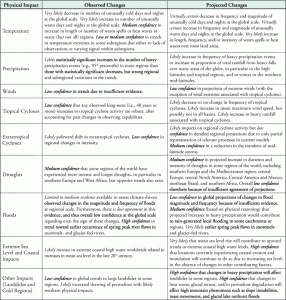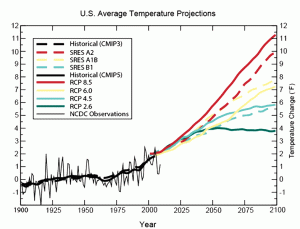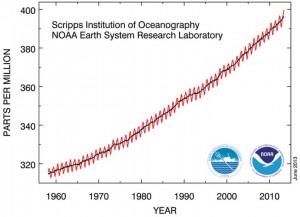Weather, climate and extreme events are key considerations in structural engineering design and practice. Weather is defined as “the state of the atmosphere with respect to wind, temperature, cloudiness, moisture, pressure, etc.” (NWS, 2013). Weather generally refers to short-term variations on the order of minutes to about 15 days (NSIDC, 2012). Climate, on the other hand, “is usually defined as the average weather, or more rigorously, as the statistical description in terms of the mean and variability of relevant quantities over a period of time ranging from months to thousands or millions of years” (IPCC, 2007). An extreme event is a weather event that is rare at a particular place and time of year (IPCC, 2007). For instance, at Washington Reagan National Airport on June 25 (Washington Post June 26, 2013), the normal high temperature is 87°F (climate), the high in 2013 was 93°F (weather) and the record high was 100°F in 1997 (extreme event).
Scientists have reached a consensus that weather, climate and extreme events of the past generally will not be representative of those of the future. Moreover, climate science is not able precisely to forecast the climate, weather and extreme events of future decades. This poses a challenge to structural engineers whose design standards are based on the assumptions of stationary climate, weather and extreme events as observed in the past. The Committee on Adaptation to a Changing Climate (CACC) of the American Society of Civil Engineers (ASCE) is addressing this in its white paper, Bridging the Gap between Climate Change Science and Civil Engineering Practice (ASCE 2013). The purpose of this article is to alert structural engineers to this challenge, inform them of the guidance available from the white paper, and invite their participation in the profession’s response to the challenge.
Current Climate Science
The Intergovernmental Panel on Climate Change (IPCC) is the leading international body for the assessment of climate change. It was established by the United Nations Environment Programme (UNEP) and the World Meteorological Organization (WMO) in 1988 to provide the world with a clear scientific view on the current state of knowledge in climate change and its potential environmental and socio-economic impacts. The Table shows the recent, qualitative IPCC assessment, based on observations and global climate models, of future weather and extreme events relevant to structural engineering design (IPCC 2012).
The U.S. Global Change Research Program (USGCRP) involves thirteen federal agencies and is led in the White House Office of Science and Technology Policy. USGCRP is preparing a National Climate Assessment (NCA), which will be issued in 2014; a draft has been available since January 2013 (NCA 2013). The draft NCA was prepared by the National Climate Assessment and Development Advisory Committee involving over 240 authors, including climate and social scientists and engineers. It has chapters on urban systems, infrastructure and vulnerability, U.S. regions, mitigation and adaptation.
Figure 1, U.S. Average Temperature Projections, taken from the draft NCA, illustrates both the potential significance of climate change for structural engineering and why climate science cannot now quantitatively forecast future climate, weather and extreme events.
The solid line for the 20th century shows an increasing trend, amounting to about 2°F for the century, with the observed variations from the trend as large as 2° F. The projections for the 21st century are derived from global climate models that consider a variety of scenarios for economic development and control of greenhouse gas emissions (Moss et al. 2010). The lowest curve is based on greenhouse gas concentrations peaking at 490 ppm carbon dioxide (CO2) equivalent and then declining; it leads to an additional 2°F increase in U.S. average temperature in the 21st century. The highest curve is based on emissions continuing to produce greenhouse gas concentration of 1,370 ppm CO2 equivalent in 2100; it leads to an additional 9°F increase. The historical trend of atmospheric CO2 is shown in Figure 2. The CO2 data (red curve) for Mauna Loa, measured as the mole fraction in dry air, constitute the longest record of direct measurements of CO2 in the atmosphere. The black curve represents the seasonally corrected data.
Greenhouse gas emissions in the 21st century will depend upon worldwide private and public policy decisions and actions, which are unpredictable, but can be represented by scenarios such as those used in preparing Figure 1.
What Can Engineers Do?
The purpose of the ASCE Committee on Adaptation to a Changing Climate (CACC) is to identify and communicate the technical requirements and civil engineering challenges for adaptation to climate change. Based on the results obtained, response activities may be planned in the Technical Activities Divisions, Technical Councils, Institutes, and other elements of ASCE. These activities may include recommendations for initiatives related to:
- climate change and its effect on the safety, health and welfare of the public as it interfaces with civil engineering infrastructure; and
- appropriate standards, loading criteria, and evaluation and design procedures for the built and natural environment, and related research and monitoring needs.
The purposes of the CACC white paper Bridging the Gap between Climate Change Science and Civil Engineering Practice (ASCE 2013) include the following:
- Fostering understanding and transparency of analytical methods necessary to update and describe climate, weather and extreme events for planning and engineering design of the built and natural environments.
- Identifying (and evaluating) methods to assess impacts and vulnerabilities caused by changing climate conditions on the built and natural environments.
- Promoting development and communication of best practices in civil engineering for addressing uncertainties associated with changing conditions, including climate, weather, extreme events, and the nature and extent of the built and natural environments.
Engineers can join in research with climate and weather scientists to develop integrated models for climate, weather and extreme events (National Academies 2012), which, combined with observations, can give probabilistic guidance for the conditions for which structures should be designed, constructed, operated and maintained.
Before such research is conducted and its results are incorporated into structural standards – a process that may take a decade or more – the question arises of what structural engineers can do to comply with the most fundamental canon in the ASCE Code of Ethics: “Engineers shall hold paramount the safety, health and welfare of the public and shall strive to comply with the principles of sustainable development in the performance of their professional duties.”
There is useful guidance in the concept of “long life, loose fit, low energy” as expressed by Alex Gordon, president of the Royal Institute of British Architects (Gordon 1972):
- Long life contributes to sustainability and reduction of greenhouse gas emissions through conservation of materials and energy required for removal and replacement. Long life can be promoted by siting to avoid susceptibility to flooding and wildfires, and using structural systems and details that are inherently resistant to extremes of temperature, wind and precipitation. However, shorter service lives, where economical, will provide opportunities to account for better knowledge of climate/weather/extremes in design of future replacements.
- Loose fit means making structures adaptable to conditions that could not be foreseen during the original design – a quality already widely exemplified by older structures in useful service today.
- Low energy, including the embodied energy in original construction and the operating energy over the structure’s service life, provides both economic benefits and reductions in the greenhouse gas emissions driving climate change.
Engineers can and should share their insights in adapting to climate change with case studies published in STRUCTURE® magazine and other media. They will ultimately guide the evolution of structural standards and practices. Engineering research, in collaboration with climate and social scientists, can improve both observations of climate/weather/extremes and modeling to provide a probabilistic understanding of the changing nature of hazards, risks and benefits as bases for appropriately evolving engineering standards.▪
References
ASCE (2013) Bridging the Gap between Climate Change Science and Civil Engineering Practice, ASCE Committee on Adaptation to a Changing Climate, will be sent in summer 2013 to ASCE institutes, divisions and councils for review and comment and will be available on the ASCE website.
Gordon (1972) Designing for survival: the President introduces his long life/loose fit/low energy study, Royal Institute of British Architects Journal, vol. 79, no. 9, p. 374-376. [Also see www.guardian.co.uk/news/1999/jul/29/guardianobituaries3]
IPCC (2007) Climate Change 2007: The Physical Science Basis, Intergovernmental Panel on Climate Change, available at www.ipcc.ch.
IPCC (2012) Managing the Risks of Extreme Events and Disasters to Advance Climate Change Adaptation, Intergovernmental Panel on Climate Change, available at www.ipcc.ch.
Moss, et.al. (2010), “The next generation of scenarios for climate change research and assessment,” Nature, 463, 747-756, [Available online at: http://emf.stanford.edu/files/docs/262/nature08823_proof1(2).pdf]
National Academies (2012). A National Strategy for Advancing Climate Modeling, National Academies Press.
NCA (2013) Federal Advisory Committee Draft Climate Assessment available at http://ncadac.globalchange.gov/
NSIDC (2012) Arctic Climatology and Meteorology Glossary (http://nsidc.org/arcticmet/glossary/weather.html; accessed October 9, 2012).
NWS (2013) National Weather Service Glossary (http://w1.weather.gov/glossary/; accessed on March 14, 2013



